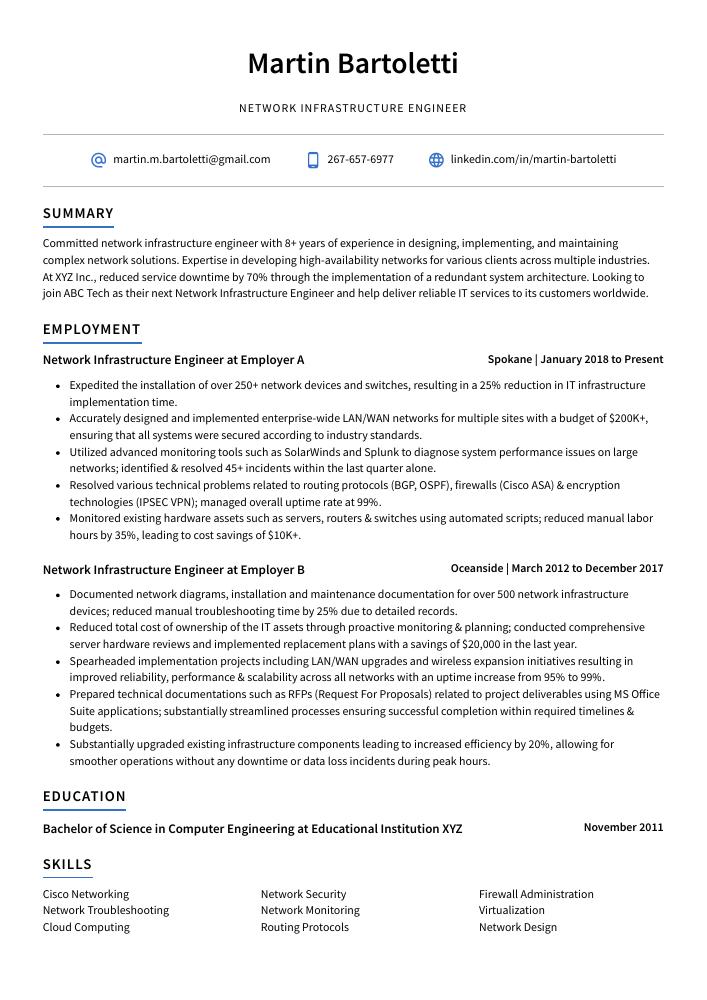Network Infrastructure Engineer Resume Guide
Network infrastructure engineers design and maintain the physical and virtual components of a network, such as routers, switches, firewalls, cables and wireless networks. They ensure that all users have access to necessary resources in the most efficient way possible by planning for future growth and troubleshooting any technical issues that arise.
Your expertise in setting up and maintaining networks makes you a valuable asset to any organization. But hiring managers don’t know who you are yet, so to make them aware of your skills and experience, you must write an eye-catching resume.
This guide will walk you through the entire process of creating a top-notch resume. We first show you a complete example and then break down what each resume section should look like.
Table of Contents
The guide is divided into sections for your convenience. You can read it from beginning to end or use the table of contents below to jump to a specific part.
Network Infrastructure Engineer Resume Sample
Martin Bartoletti
Network Infrastructure Engineer
martin.m.bartoletti@gmail.com
267-657-6977
linkedin.com/in/martin-bartoletti
Summary
Committed network infrastructure engineer with 8+ years of experience in designing, implementing, and maintaining complex network solutions. Expertise in developing high-availability networks for various clients across multiple industries. At XYZ Inc., reduced service downtime by 70% through the implementation of a redundant system architecture. Looking to join ABC Tech as their next Network Infrastructure Engineer and help deliver reliable IT services to its customers worldwide.
Experience
Network Infrastructure Engineer, Employer A
Spokane, Jan 2018 – Present
- Expedited the installation of over 250+ network devices and switches, resulting in a 25% reduction in IT infrastructure implementation time.
- Accurately designed and implemented enterprise-wide LAN/WAN networks for multiple sites with a budget of $200K+, ensuring that all systems were secured according to industry standards.
- Utilized advanced monitoring tools such as SolarWinds and Splunk to diagnose system performance issues on large networks; identified & resolved 45+ incidents within the last quarter alone.
- Resolved various technical problems related to routing protocols (BGP, OSPF), firewalls (Cisco ASA) & encryption technologies (IPSEC VPN); managed overall uptime rate at 99%.
- Monitored existing hardware assets such as servers, routers & switches using automated scripts; reduced manual labor hours by 35%, leading to cost savings of $10K+.
Network Infrastructure Engineer, Employer B
Oceanside, Mar 2012 – Dec 2017
- Documented network diagrams, installation and maintenance documentation for over 500 network infrastructure devices; reduced manual troubleshooting time by 25% due to detailed records.
- Reduced total cost of ownership of the IT assets through proactive monitoring & planning; conducted comprehensive server hardware reviews and implemented replacement plans with a savings of $20,000 in the last year.
- Spearheaded implementation projects including LAN/WAN upgrades and wireless expansion initiatives resulting in improved reliability, performance & scalability across all networks with an uptime increase from 95% to 99%.
- Prepared technical documentations such as RFPs (Request For Proposals) related to project deliverables using MS Office Suite applications; substantially streamlined processes ensuring successful completion within required timelines & budgets.
- Substantially upgraded existing infrastructure components leading to increased efficiency by 20%, allowing for smoother operations without any downtime or data loss incidents during peak hours.
Skills
- Cisco Networking
- Network Security
- Firewall Administration
- Network Troubleshooting
- Network Monitoring
- Virtualization
- Cloud Computing
- Routing Protocols
- Network Design
Education
Bachelor of Science in Computer Engineering
Educational Institution XYZ
Nov 2011
Certifications
Cisco Certified Network Professional (CCNP)
Cisco Systems
May 2017
1. Summary / Objective
Your resume summary should be a concise and compelling summary of your network infrastructure engineering experience. This is the place to highlight your technical skills, such as knowledge of routing protocols, firewalls, VPNs and other networking technologies. You can also mention any certifications you have obtained or awards won in this field. Additionally, it’s important to demonstrate how you solved complex problems for previous employers by providing tangible results that improved their networks’ performance and reliability.
Below are some resume summary examples:
Reliable network infrastructure engineer with 5+ years of experience in designing, deploying, and maintaining high-end networks. Specializes in developing secure environments for mission critical applications. Experienced with troubleshooting complex network problems and optimizing performance through proactive monitoring. At XYZ, reduced downtime by 20% while increasing uptime to 99%. Delivered a robust network design that saved the company $30K annually.
Seasoned network infrastructure engineer with 5+ years of experience deploying, managing, and troubleshooting complex IT networks. Skilled in the administration of routers, switches, firewalls, servers and other network devices. Experienced in setting up secure intranets for businesses to ensure data security and compliance with industry standards. Track record of successful implementations that resulted in improved performance while reducing costs.
Skilled network infrastructure engineer with 10+ years of experience in designing, deploying and troubleshooting enterprise-level networks. At XYZ Inc., managed the design and implementation of over 30 corporate networks for companies ranging from small businesses to large enterprises. Proven record in developing secure environments that meet or exceed industry standards while reducing costs through efficient network optimization techniques.
Driven network infrastructure engineer with 5+ years of experience in designing, deploying, and maintaining complex network solutions for medium-sized businesses. At XYZ Company successfully configured a new WAN/LAN system that increased bandwidth by 300%. Developed comprehensive maintenance plans to ensure optimal performance of routers and switches. Possess strong knowledge of security protocols and tools used to prevent data breaches.
Passionate network infrastructure engineer with 5+ years of experience designing, implementing and maintaining corporate networks. In previous roles, implemented an automated monitoring system that improved the detection rate of faults by 40%. Seeking to join ABC Tech as a network infrastructure engineer where I can use my knowledge and expertise in developing reliable solutions for complex IT systems.
Diligent network infrastructure engineer with 7+ years of experience designing, deploying, and maintaining complex network solutions. Successfully implemented Cisco-based routing and switching networks for multiple clients resulting in improved performance by 15%. Looking to join ABC’s team as a senior network engineer to leverage my expertise in troubleshooting issues related to WAN/LAN connectivity.
Determined network infrastructure engineer with 5+ years of experience designing and implementing complex network solutions. Achieved cost savings of over $120K/year by introducing a new enterprise-wide network architecture to Company X. Seeking an opportunity at ABC Tech to leverage my knowledge in IP networking, VPNs, Firewalls, Wi-Fi systems and VoIP technologies for the benefit of their clients.
Dependable network infrastructure engineer with 5+ years of experience in designing, deploying and troubleshooting complex network infrastructures. Highly skilled in setting up routers, switches, servers and firewalls. At XYZ successfully led the design and implementation of a new company-wide WAN/LAN system that increased productivity by 15%.
2. Experience / Employment
The work history/experience section is where you provide details on your employment history. This should be written in reverse chronological order, meaning that the most recent role is listed first.
When discussing what you did for each job, stick to bullet points; this makes it easier for the reader to take in and understand what you are saying quickly. You want to think about the specific tasks you completed and any quantifiable results obtained from them when writing these bullets.
For example, instead of saying “Installed network infrastructure,” say something like “Designed a secure wireless network architecture with 802-11n protocol which increased data transfer speeds by 40%.”
To write effective bullet points, begin with a strong verb or adverb. Industry specific verbs to use are:
- Configured
- Monitored
- Implemented
- Troubleshot
- Optimized
- Installed
- Resolved
- Analyzed
- Upgraded
- Documented
- Tested
- Managed
- Secured
- Designed
- Administered
Other general verbs you can use are:
- Achieved
- Advised
- Assessed
- Compiled
- Coordinated
- Demonstrated
- Developed
- Expedited
- Facilitated
- Formulated
- Improved
- Introduced
- Mentored
- Participated
- Prepared
- Presented
- Reduced
- Reorganized
- Represented
- Revised
- Spearheaded
- Streamlined
- Structured
- Utilized
Below are some example bullet points:
- Developed and implemented network infrastructure projects, resulting in a 20% improvement of system stability and an increase in overall bandwidth capacity.
- Formulated best practices for maintenance and installation plans to ensure that all networks ran efficiently while reducing downtime by 30%.
- Consistently monitored performance metrics to identify any anomalies or issues within the network; identified and resolved 40+ incidents on time each month.
- Represented the organization at vendor meetings with suppliers regarding new products, services, technology upgrades and pricing negotiations; saved up to $5000 per year due to successful negotiations.
- Upgraded existing hardware components such as routers, switches & firewalls based on company specifications resulting in improved reliability across multiple locations/sites.
- Reliably managed and maintained a network infrastructure of over 500+ devices, reducing downtime by 15% within the first 6 months.
- Demonstrated strong troubleshooting skills to identify and resolve complex technical issues with routers, switches, servers & firewalls in a timely manner for improved system performance.
- Installed new hardware components such as modems, cables & wireless access points to expand existing networks across multiple sites; increased overall capacity by 40%.
- Compiled detailed documentation on network configuration changes and updates; created user-friendly instruction manuals which facilitated an easier transition period when onboarding new team members or consultants.
- Coordinated with vendors regarding software upgrades/patches installation to ensure all systems were up-to-date according to industry regulations; reduced security risks associated with outdated versions by 25%.
- Improved network performance by 30% through the redesign of system infrastructure, and implemented new network protocols to increase security.
- Revised existing IT architectures in accordance with industry standards and best practices; successfully upgraded 20+ servers within budget constraints.
- Assessed current networks for potential bottlenecks or vulnerabilities, providing recommendations for remediation when needed.
- Independently managed the installation and configuration of all routers, switches, firewalls and other networking equipment in a timely manner across multiple sites worldwide on tight timelines; completed projects 5 days ahead of schedule on average.
- Troubleshot a wide range of complex technical issues pertaining to network configurations & connectivity problems using advanced tools such as Wireshark and NetFlow Analyzers; reduced downtime incidents by 25%.
- Configured and maintained over 200 network and security infrastructure devices, ensuring that all data was securely transmitted with no breaches or interruptions; reduced downtime by 45%.
- Implemented cutting-edge technologies such as 802.11ac Wi-Fi, IPv6 and QoS to enhance performance of the entire corporate network while reducing bandwidth costs by $5,000 per month.
- Streamlined IT operations through automated tasks using scripting languages like PowerShell and Bash to improve system reliability by 30% within 6 months of joining the company.
- Analyzed user requirements for robust networks in terms of hardware components & software upgrades; implemented solutions accordingly resulting in a 25% reduction in customer support tickets related to networking issues annually.
- Competently diagnosed complex technical problems across different layers (network protocols, routers/switches) and provided timely resolutions within SLA limits; resolved over 50 incidents successfully each quarter on average without any disruption or data loss.
- Secured data and network infrastructure for an organization with over 2,000 users by implementing security measures such as firewalls, anti-virus software and intrusion detection systems; decreased cyber threats by 82%.
- Optimized the performance of networking operations through troubleshooting complex issues; improved network uptime to 99% within two months.
- Actively monitored all system components including servers, routers and switches to ensure optimal performance; identified potential problems before they caused disruptions in service availability.
- Mentored junior team members on effective techniques for diagnosing technical faults on networks while also ensuring compliance with industry standards such as IEEE 802 protocols & TCP/IP configurations; provided training that resulted in a 22% increase in personnel efficiency levels during production hours.
- Introduced multiple new features into existing hardware architecture which included virtual private networks (VPNs), cloud computing solutions & wireless access points (WAP); increased overall productivity levels across the entire IT department by 25%.
- Designed, implemented and maintained a secure network infrastructure for multiple sites, resulting in increased efficiency by up to 30%.
- Structured and documented the layouts of networks utilizing topologies such as LAN/WAN, client-server architectures and cloud solutions; improved system performance by 45% within three months.
- Reorganized existing systems in order to meet the increasing demands of customers; optimized resources used for networking with minimal downtime over two years’ time period.
- Participated actively in trouble shooting process during outages or security breaches, effectively resolving cases within 24 hours on average while providing timely updates to management team along the way.
- Proficiently utilized various tools such as Wireshark, Snort IDS & IPS technologies alongside TCP/IP protocols when setting up firewalls & routers across different locations; reduced data transfer latency rate significantly by 10%.
- Presented technical plans and strategies to business stakeholders, facilitating the implementation of new network infrastructure projects that increased data accessibility by 50%.
- Facilitated a wide range of installation and maintenance activities on hardware components including routers, switches, firewalls and cabling systems with meticulous attention to detail; reduced system downtime incidents by 70%.
- Tested network performance using various tools such as Wireshark & SolarWinds; identified areas for improvement that led to an increase in overall bandwidth speed by 40%.
- Coordinated cross-functional teams comprising technicians and IT engineers during large scale upgrades, ensuring all tasks were completed within agreed timelines (averaging 20 hours per project).
- Monitored user activity logs daily to detect malicious traffic behavior while providing technical support on issues related to networks configurations or malfunctions as needed.
- Administered network infrastructure in a multi-site environment, consisting of 25+ computers and servers connected via LAN/WAN; reduced downtime by 50%.
- Thoroughly tested network hardware for compatibility, reliability and performance to ensure uninterrupted operations across all sites; decreased latency times by 20%.
- Advised IT personnel on best practices for configuring routers, firewalls and other components to optimize system security; improved firewall protection efficiency by 12%.
- Achieved successful integration of multiple virtualized networks into one central hub with no user disruptions or data loss within 4 weeks of implementation.
3. Skills
Even though two organizations are hiring for the same role, the skillset they want an ideal candidate to possess could differ significantly. For instance, one may be on the lookout for an individual who is experienced with Cisco routers, while the other may be looking for someone who has worked on Juniper switches.
It’s essential to tailor your skills section of your resume to each job you are applying for; otherwise, it could end up in a digital abyss due to applicant tracking systems that scan resumes for certain keywords before passing them onto human recruiters.
Once listed here, you can further elaborate on the most relevant ones by discussing them in more detail (such as how they have been used) in other areas like the summary or experience sections.
Below is a list of common skills & terms:
- Cisco Networking
- Cloud Computing
- Firewall Administration
- Network Automation
- Network Design
- Network Monitoring
- Network Security
- Network Troubleshooting
- Routing Protocols
- Virtualization
4. Education
Mentioning your education on your resume will depend on how far into your career you are. If you just graduated and have no prior experience, include an education section below the resume objective. However, if you already have plenty of work experience to showcase, it might be best to omit the education section altogether.
If including an education section is necessary for this network infrastructure engineer role, try to mention courses and subjects related to networking or engineering that are relevant for the job position.
Bachelor of Science in Computer Engineering
Educational Institution XYZ
Nov 2011
5. Certifications
Certifications are a great way to demonstrate your expertise in a particular field. They show potential employers that you have taken the time and effort to become certified, which can set you apart from other applicants.
When listing certifications on your resume, make sure they are relevant to the job for which you are applying. This will help hiring managers see how well-suited you are for the position and give them an idea of what kind of value you could bring to their organization.
Cisco Certified Network Professional (CCNP)
Cisco Systems
May 2017
6. Contact Info
Your name should be the first thing a reader sees when viewing your resume, so ensure its positioning is prominent. Your phone number should be written in the most commonly used format in your country/city/state, and your email address should be professional.
You can also choose to include a link to your LinkedIn profile, personal website, or other online platforms relevant to your industry.
Finally, name your resume file appropriately to help hiring managers; for Martin Bartoletti, this would be Martin-Bartoletti-resume.pdf or Martin-Bartoletti-resume.docx.
7. Cover Letter
A cover letter is an important part of a job application and provides recruiters with more information about your skills, experience and suitability for the role. It’s typically made up of 2 to 4 paragraphs that are separate from your resume.
Whilst not always required, writing a cover letter is highly recommended as it allows you to showcase yourself in a way that cannot be done on paper or through an online form alone. You can use this opportunity to explain why you’re uniquely qualified for the position and what makes you the perfect candidate for the job.
Below is an example cover letter:
Dear Sallie,
I am writing to apply for the Network Infrastructure Engineer position at [company name]. With more than 10 years of experience in network administration and engineering, I am confident that I can be an asset to your organization.
In my current role as a Network Administrator at [company name], I manage a team of five engineers responsible for designing, implementing, and maintaining the company’s network infrastructure. Our team has successfully designed and implemented multiple high-availability solutions that have increased uptime by 30%. In addition, we have created automated monitoring and reporting systems that have reduced the mean time to repair by 50%.
I am knowledgeable in a variety of networking technologies, including routers, switches, firewalls, load balancers, and VPNs. My hands-on experience with these technologies has allowed me to develop a strong understanding of how they work together to create reliable and secure networks. In addition, I have developed excellent problem-solving skills that allow me to quickly identify and resolve issues when they arise.
I believe my skills and experience would make me an ideal candidate for this position. I am eager to utilize my knowledge and expertise to help [company name] build reliable and secure networks that meet the ever-changing needs of its users. Thank you for your time and consideration; I look forward to speaking with you soon about this opportunity.
Sincerely,
Martin
Network Infrastructure Engineer Resume Templates
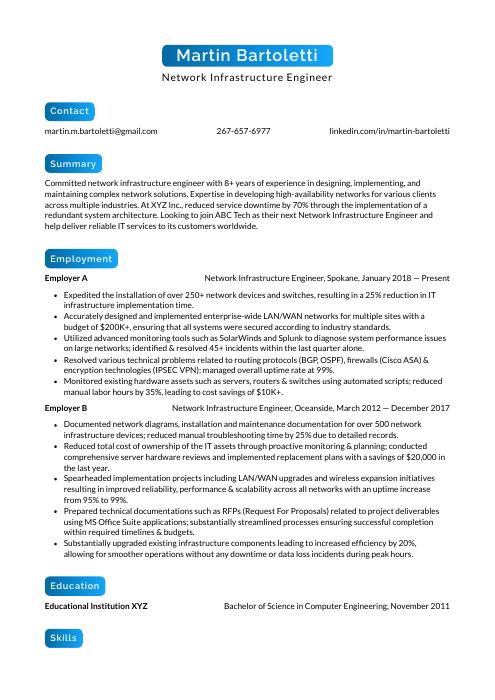 Kinkajou
Kinkajou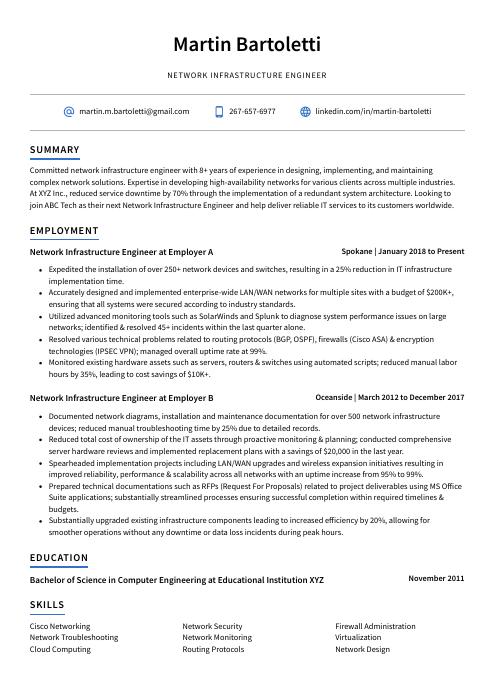 Axolotl
Axolotl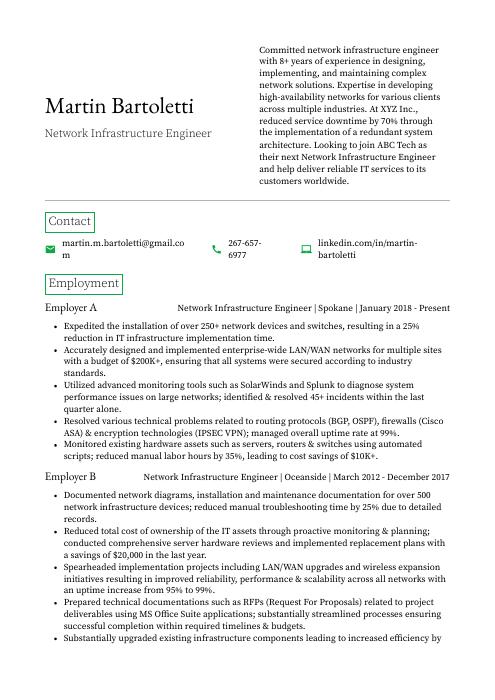 Quokka
Quokka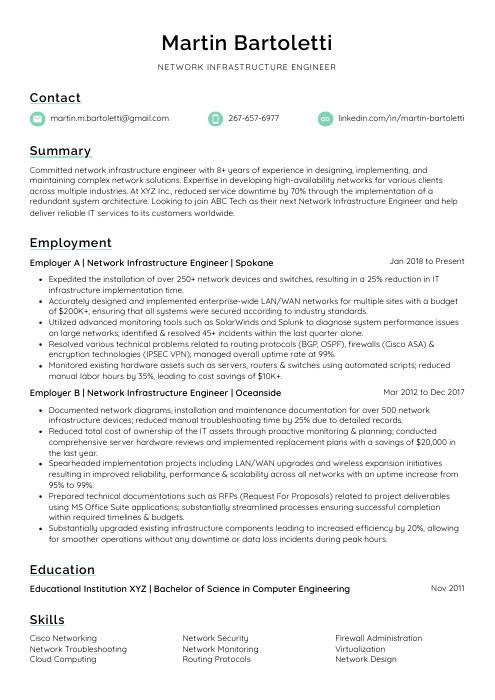 Lorikeet
Lorikeet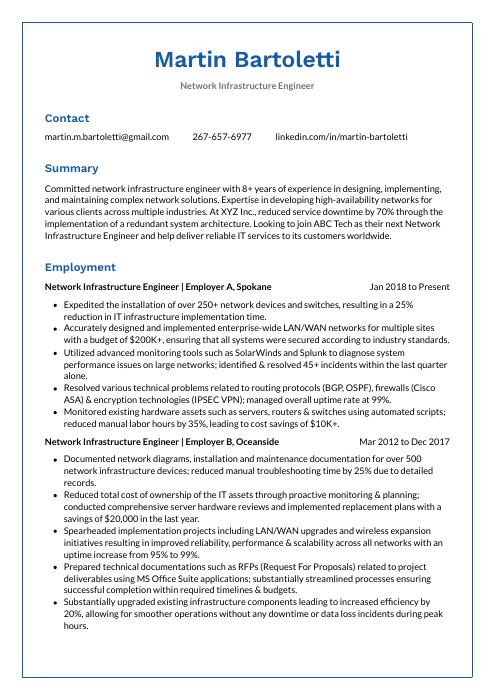 Markhor
Markhor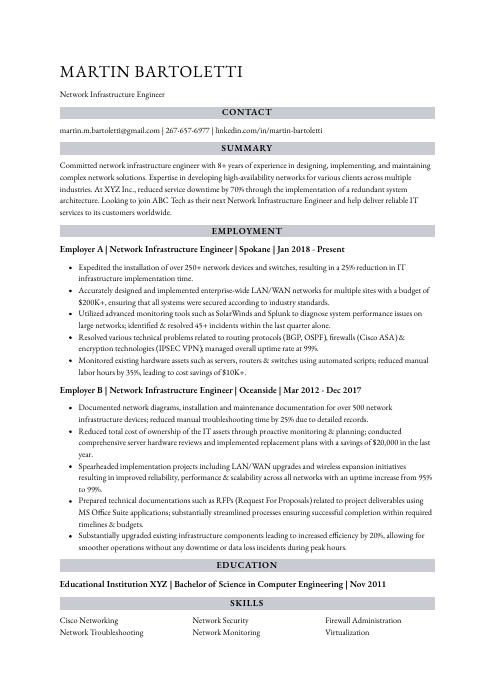 Numbat
Numbat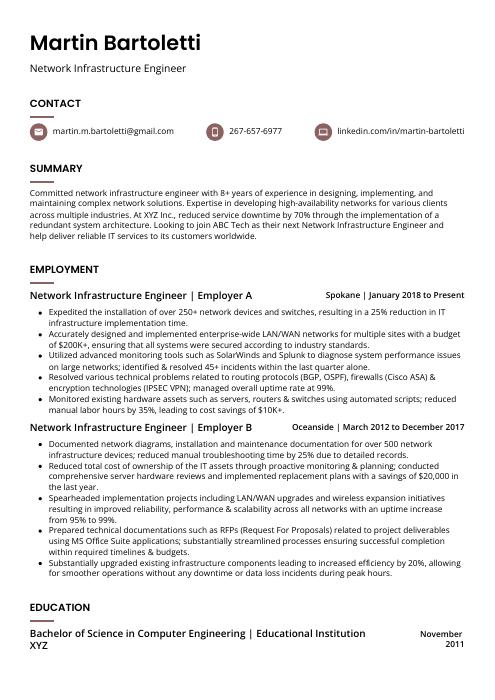 Fossa
Fossa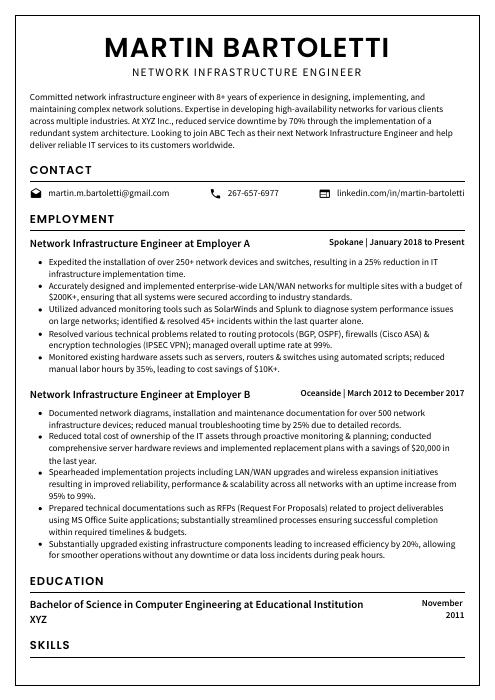 Cormorant
Cormorant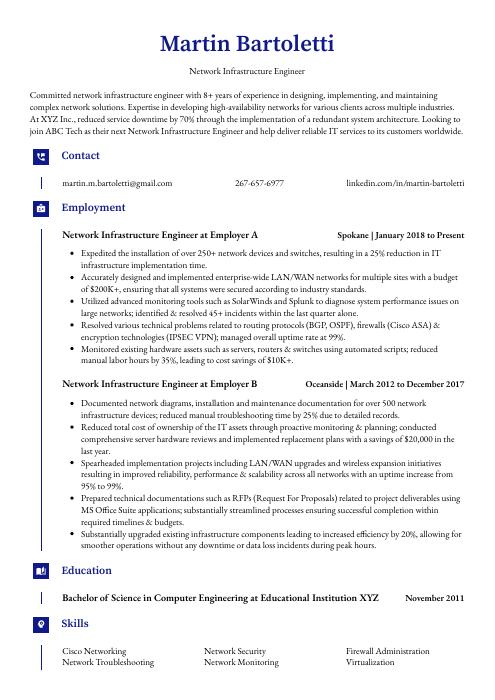 Gharial
Gharial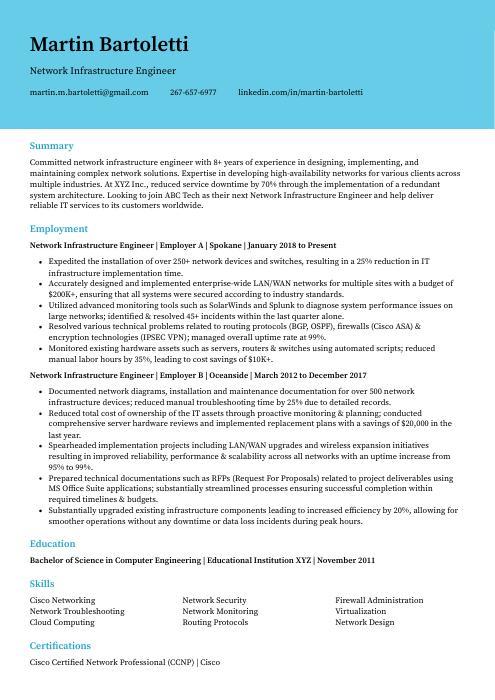 Dugong
Dugong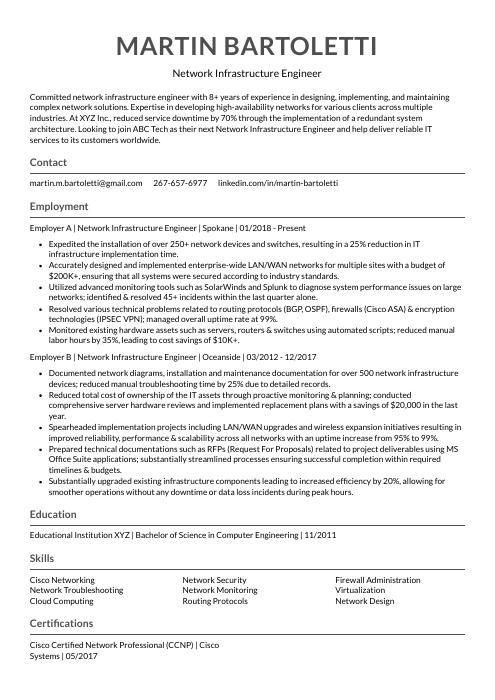 Indri
Indri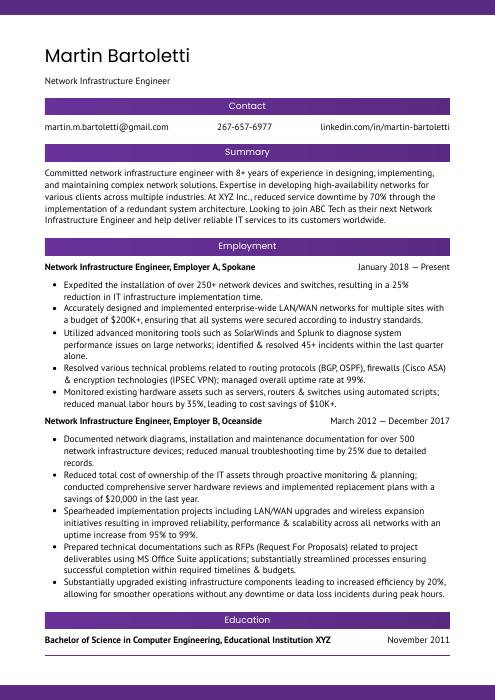 Jerboa
Jerboa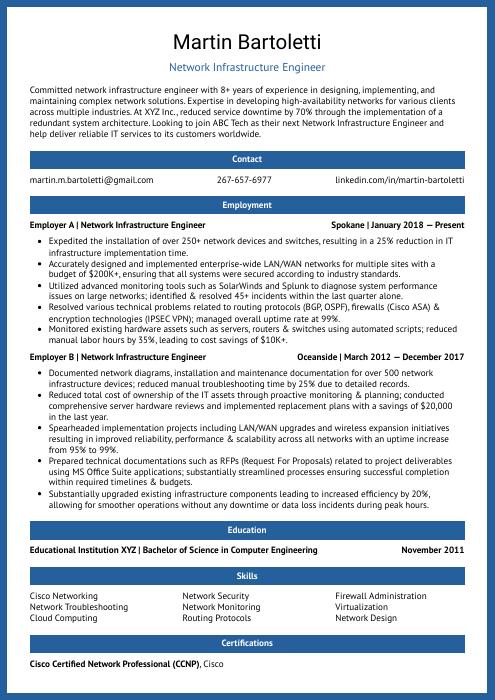 Ocelot
Ocelot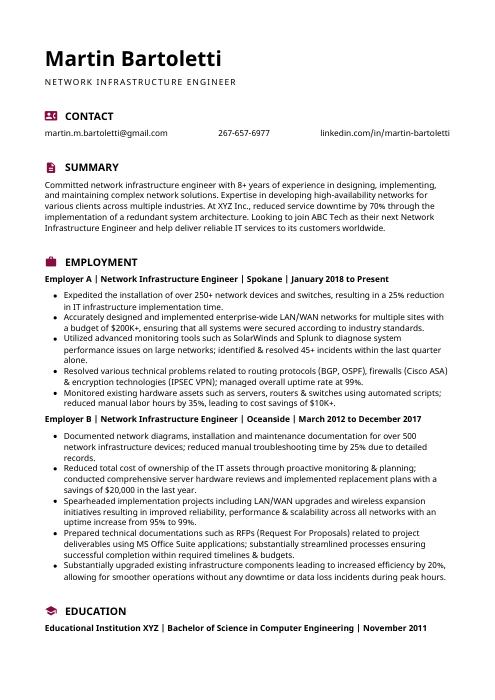 Hoopoe
Hoopoe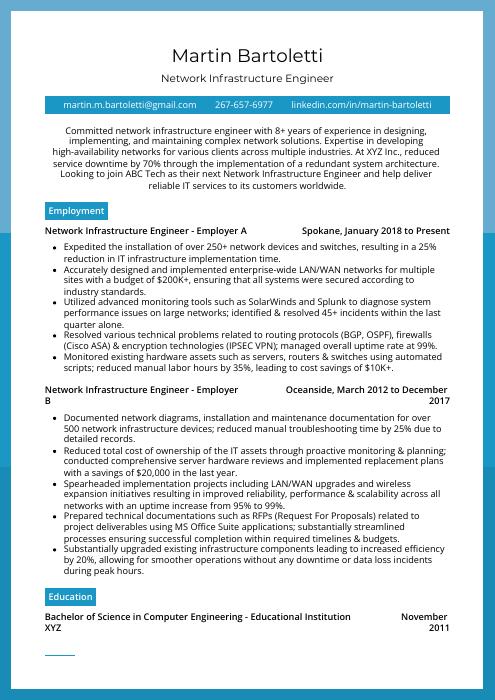 Rhea
Rhea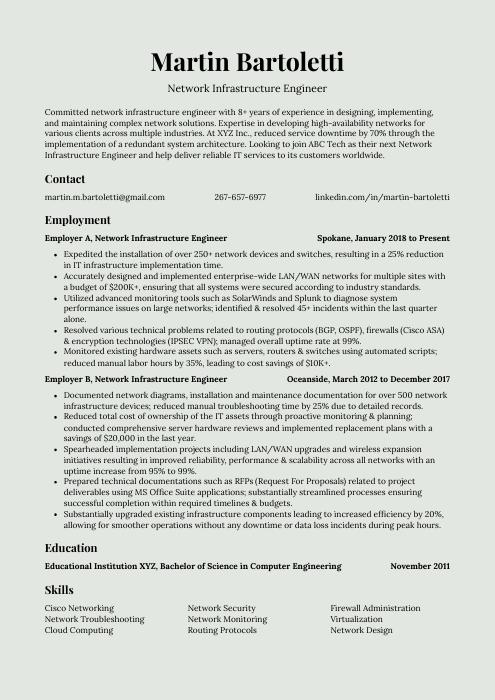 Saola
Saola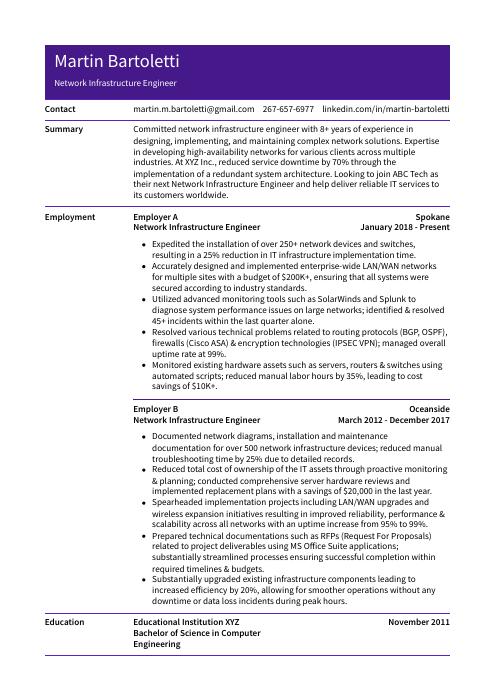 Pika
Pika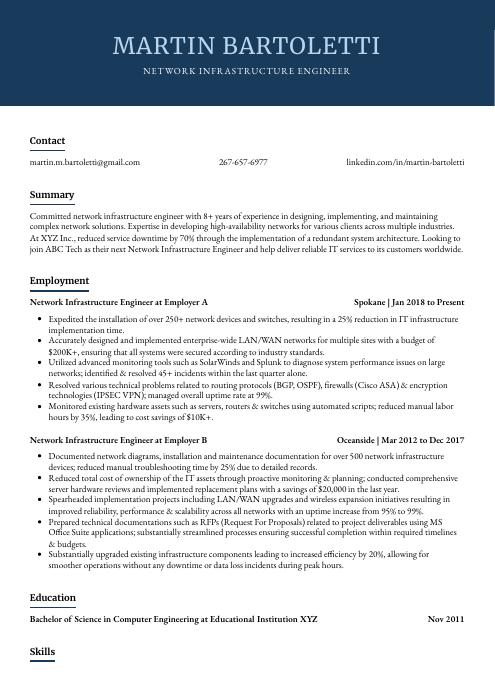 Bonobo
Bonobo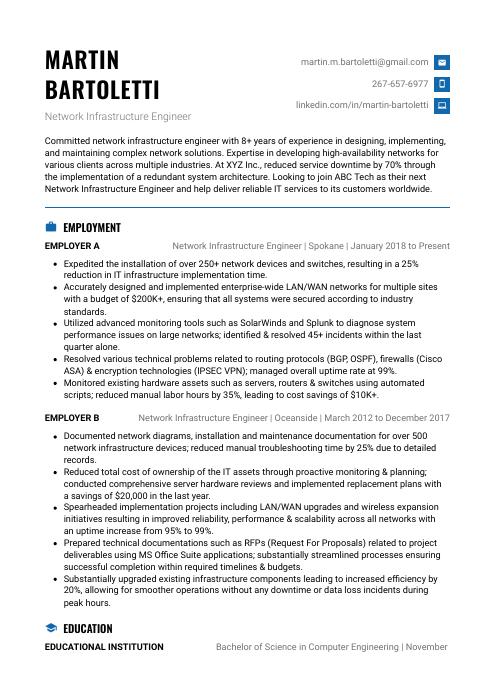 Echidna
Echidna Rezjumei
Rezjumei
